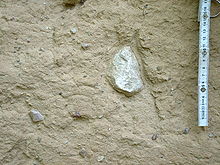Glacial till
The sediment marl or till is the sediment that is deposited directly from the glacier at its base. It is the typical sediment of the ground moraine .
Emergence
Glacier ice as a solid body does not sort the moraine material it moves, neither when it is picked up nor during transport. When the glacier melts, the material is then deposited again unsorted. For this reason, sediment marl is considered to be diamictite and contains all grain size classes from clay to silt , sand , gravel and stones ( sediment ) to boulders . In the outcrop it appears generally bulky, unsorted and unlayered. However, as a special case, stratified glacial till can also be deposited. The proportion of the individual grain size fractions can fluctuate greatly; clayey-silty as well as sandy or stony boulder clay occur. It is also possible that lentils or inclusions with sorted sediments occur within the otherwise unsorted glacial till , e.g. B. by recording from the underground. The color of the glacial till in the outcrop is just as variable. Although gray tones predominate, yellowish, reddish or bluish colors also occur. In northern Germany, the carbonate content of the till comes from relocated and ground chalk (rock) , in southern Germany and Austria from the Northern Limestone Alps , in Switzerland and France mainly from the limestone of the Helveticum .
Subsequent weathering can wash out (loosen) the carbonate from the till. The result is lime-free boulder clay . Boulder clay also occurs primarily in the carbonate-free areas of origin of the glaciers, for example in the Central Alps. If the till contains many blocks of rock, it is called block clay .
In the areas of northern and southern Germany that were glaciated during the Pleistocene, marl boulders are the most widespread deposits, alongside meltwater sands and gravel. They are either directly on the surface of the earth or covered by younger deposits. Their thickness fluctuates very strongly and is between 0 and more than 100 meters. In addition, they can be found in all formerly glaciated areas of the world.
In Central Europe brown earth , lessivés or related soils are mostly produced from the boulder clay and / or the boulder clay . They are generally fertile and valuable for agriculture. That is why most of the ground moraine areas in Central Europe are used as arable land today.
In recent years, the Gaelic word Till has become commonplace in specialist literature for both marl and silt. Deposits from older ice ages that were solidified into solid rock, on the other hand, are called tillites .
See also
literature
- Jürgen Ehlers : General and historical Quaternary geology. Stuttgart 1994, ISBN 3-432-25911-5 .
- Sven Lukas: Moraine or Till? A suggestion for the description, interpretation and naming of glacial sediments. In: Journal of Glacier Science and Glacial Geology. Vol. 39, 2003/04, pp. 141-159.
- Hans Murawski : Geological Dictionary. 8th edition. Ferd. Enke, Stuttgart 1983, ISBN 978-3-432-84108-3 , p. 80.
- Dieter Richter : General Geology. 3. Edition. De Gruyter, Berlin, New York 1985, ISBN 3-110-10416-4 , p. 126.
- Fritz Scheffer : Textbook of soil science / Scheffer / Schachtschabel. Revised and expanded by Hans-Peter Blume, among others, 15th edition. Spektrum, Heidelberg, Berlin 2002, ISBN 3-8274-1324-9 , p. 470 f.
- JA Piotrowski: What is a till? In: The Geosciences. Vol. 4, 1992, doi : 10.2312 / geoswissenschaften . 1992.10.100, pp. 100-108.
